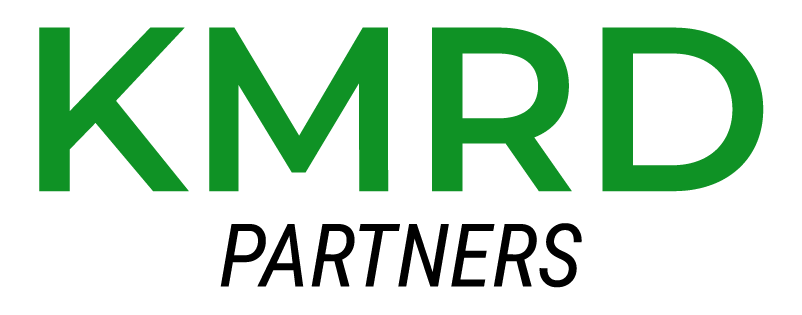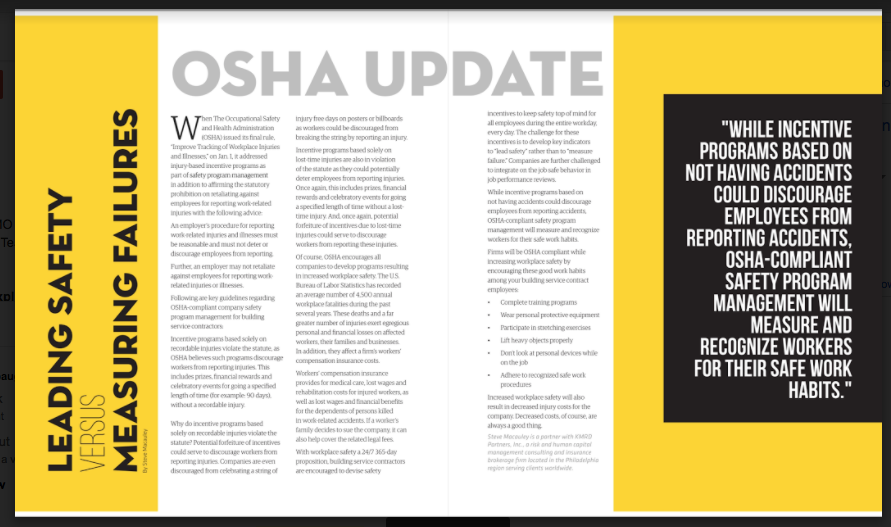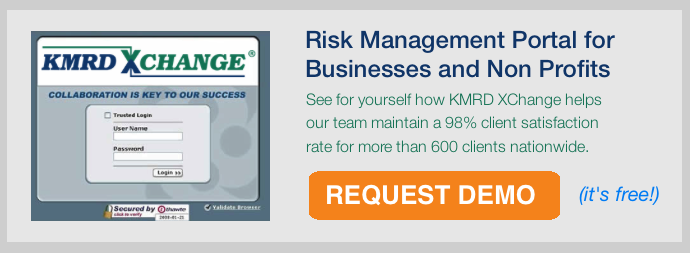Leading Safety versus Measuring Failures – Safety Incentive Programs
The Occupational Safety and Health Administration (“OSHA”) issued its final rule to “Improve Tracking of Workplace Injuries and Illnesses” on January 1, 2017. It addressed injury-based safety incentive programs as part of safety program management in addition to affirming the statutory prohibition on retaliating against employees for reporting work-related injuries with the following advice:
- An employer’s procedure for reporting work-related injuries and illnesses must be reasonable and must not deter or discourage employees from reporting.
- Further, an employer may not retaliate against employees for reporting work-related injuries or illnesses.
Following are key guidelines regarding OSHA compliant company safety program management for building service contractors:
- Safety incentive programs based solely on recordable injuries violate the statute, as OSHA believes such programs discourage workers from reporting injuries. This includes prizes, financial rewards and celebratory events for going a specified length of time – for example, 90 days, without a recordable injury. Why do incentive programs based solely on recordable injuries violate the statute? Potential forfeiture of incentives could serve to discourage workers from reporting injuries. Companies are even discouraged from celebrating a string of injury free days on posters or billboards, as workers could be discouraged from breaking the string by reporting an injury.
- Safety incentive programs based solely on lost-time injuries are also in violation of the statute, as they could potentially deter employees from reporting injuries. Once again, this includes prizes, financial rewards and celebratory events for going a specified length of time without a lost-time injury. And once again, potential forfeiture of incentives due to lost-time injuries could serve to discourage workers from reporting these injuries.
Of course, OSHA encourages all companies to develop programs resulting in increased workplace safety. The US Bureau of Labor Statistics has recorded an average number of 4,500 annual workplace fatalities during the past several years. These deaths and a far greater number of injuries exert egregious personal and financial losses on affected workers, their families and businesses. In addition, they affect a firm’s Workers’ Compensation Insurance costs.
Workers’ Compensation Insurance provides for medical care, lost wages and rehabilitation costs for injured workers, as well as lost wages and financial benefits for the dependents of persons killed in work-related accidents. If a worker’s family decides to sue the company, it can also help cover the related legal fees.
With workplace safety a 24/7/365 day proposition, building service contractors are encouraged to devise safety incentives to keep safety top of mind for all employees during the entire workday, every day. The challenge for these incentives is to develop key indicators to “lead safety” rather than to “measure failure.” Companies are further challenged to integrate on the job safe behavior in job performance reviews.
While safety incentive programs based on not having accidents could discourage employees from reporting accidents, OSHA compliant safety program management will measure and recognize workers for their safe work habits.
Firms will be OSHA compliant while increasing workplace safety by encouraging these good work habits among your building service contract employees:
- Complete training programs
- Wear personal protective equipment
- Participate in stretching exercises
- Lift heavy objects properly
- Don’t look at personal devices while on the job
- Adhere to recognized safe work procedures
Increased workplace safety will also result in decreased injury costs for the company. Decreased costs, of course, are always a good thing.
Contact us below to learn more about OSHA or how this OSHA ruling might affect your business.

Steve Macauley is a Partner with KMRD Partners, Inc., a risk and human capital management consulting and insurance brokerage firm located in the Philadelphia region serving clients worldwide.
Contact UsSee the KMRD Advantage About KMRD
Note: This content is provided as general background information and should not be taken as legal advice or financial advice for your particular situation. Make sure to get individual advice on your case from a KMRD risk professional before taking any action.







